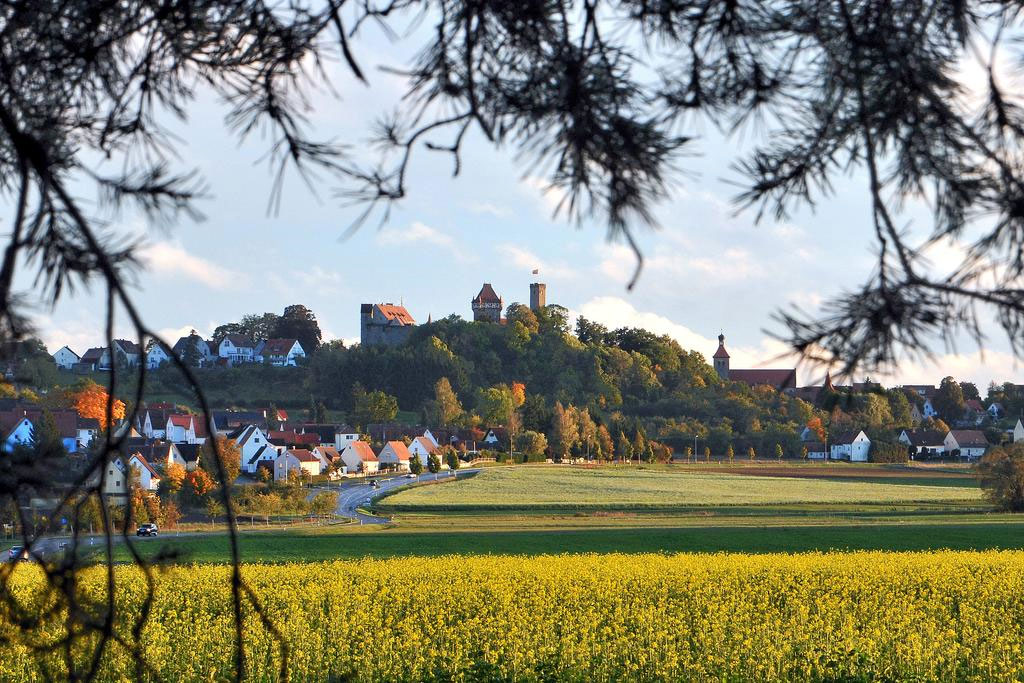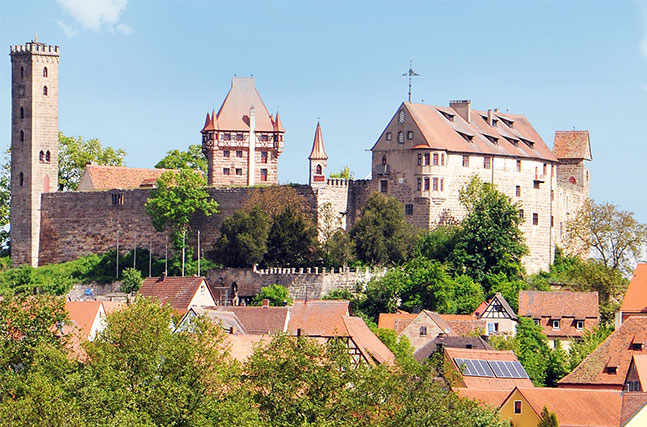HistoryBurg Abenberg
Abenberg Castle lies above the alluring, pleasant town of Abenberg in Central Franconia It is often referred to as the crown of the Rangau.
The history of the Abenberg family dates back to the 11th century. Count Adalbert II (approx. 1040-1059) was responsible for the first rendition of the castle, which was largely built of wood. Count Rapoto (1122-1172) replaced his predecessors’ structure between 1130-1140 with one of Bavaria’s most impressive stone castles (40 x 40m). The Abenberger nobility, whose last count Friedrich II was praised by Tannhäuser for his promotion of poetry, ultimately perished around 1200.[1]
1236 kommen Stadt und Burg durch Heirat an die Hohenzollern, die damaligen Burggrafen von Nürnberg, nachdem die männliche Linie der Abenberger mit Graf Friedrich II. erloschen war. 1230–1250 ersetzen die Nürnberger den salierzeitlichen Bau durch einen teilweisen Neubau, den sie aber kaum benutzten. Dazu wurde die Ringmauer abgebrochen und die Hauptburg auf die doppelte Größe erweitert. Die Frontseite wurde verdickt und am Südosteck das wehrhafte Burgtor errichtet. Die hierbei neu errichtete Ringmauer ist heute der älteste erhaltene Teil der Burg.
The castle was sold in 1296 to the Prince-bishop of Eichstätt, who overlooked the fortification of the estate’s defense and strengthened the weak north-western corner with a watchtower.
The castle was fraught with a number of costly renovations in the 15th, 16th, and 17th centuries. From 1496, new maintenance buildings were consistently built in the eastern corner and new commercial enterprises were established inside the castle. Increased expenditure ultimately led to the bankruptcy of the castle, culminating in the collapse of the St. Otmars Chapel in 1799.
Due to the increasing secularization of the country, the castle came into possession the Kingdom of Bavaria in 1806, which moved to sell it for demolition. However, the castle’s complete destruction was prevented by Bavarian art dealer KJ Zwerschina, who bought Abenberg Castle in 1875. He oversaw the reconstruction of numerous towers, such as the 33-meter-high Luginsland. The next owner, the distinguished opera singer Anton Schott, continued Zwerschina’s work from 1881-1913. After that, however, the castle once again fell into disrepair.
The town of Abenberg came into ownership of half of the property in 1982, then acquired the rest in 1984. In order to be able to finance renovation and maintenance, Abenberg – in conjunction with the district of Roth and the district of Middle Franconia – founded the Burg Abenberg Association on March 8, 1986, which took over ownership. The Association’s aim was to preserve the castle and to revitalize it culturally, thus establishing a museum and catering business.
In the years following the castle’s acquisition, numerous renovation and expansion works taken place done, ending in 2001 with the opening of the bobbin lace museum. Several excavations were carried out during the renovation works in 1988–1992, which help provide architectural records for the castle’s long and tumultuous history.

